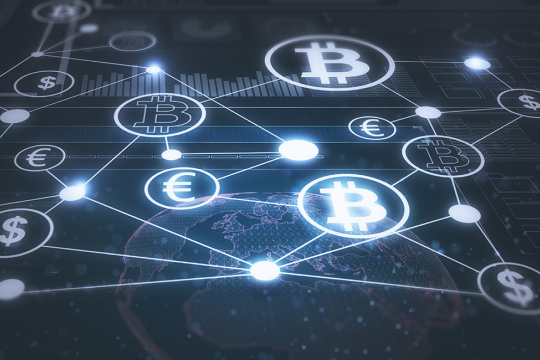
What is DeFi and How Does it Work?
You may have heard the word “DeFi” and thought it was the title of a futuristic film. Or, maybe you read about it when trying to find information on how the crypto space operates.
DeFi, short for decentralized finance, is blockchain-based technology designed to allow users to perform financial transactions – like lending, banking and investing – with cryptocurrencies without needing traditional market participants, like a bank. The growing popularity of cryptocurrencies is one of the main drivers behind the development of alternative banking.
This guide will help you understand what DeFi is, the technology behind it, and some of the risks that arise with this emerging technology.
What is DeFi?
First, to understand DeFi, it is important to understand our current centralized financial system.
Financial services markets are traditionally overseen by different regulators. To gain access to money, one must work with financial intermediaries for auto loans, mortgages, brokerage accounts, investment accounts, stocks and bonds. Regulators set the guidelines and rules consumers must meet to get a bank account, access loans and invest.
As users of these services, we must comply with these laws and rules to access money.
DeFi is an alternative approach. Unlike traditional banks and investment firms, DeFi financial services firms use digital assets, instead of fiat currency, to provide banking and financial services, such as lending, investing and management services.
Defi vs Traditional Banking
In the current banking system, a customer opens a savings account and earns interest on the deposit. The bank lends the money you and other customers have deposited to another customer or business at a higher interest rate and takes a profit on the difference. The idea behind DeFi, using the example above, is that you could earn the full amount of interest paid by the borrower instead of some lesser amount set by the bank.
What is the technology behind DeFi?
If you’re familiar with cryptocurrencies, you’ve probably heard of Bitcoin and Ethereum. They are two of the most popular cryptocurrencies in an ever-growing and vast marketplace.
Bitcoin and Ethereum are not just cryptocurrencies. They are built on blockchain technology, a decentralized digital ledger that shows Bitcoin and Ethereum transactions. Blockchain technology allows users to — among other things — obtain, sell and invest in digital assets, like cryptocurrencies.
DeFi uses the blockchain to allow users to engage in financial activities without any regulatory oversight and to handle finances on a peer-to-peer level.
The DeFi blockchain technology is run using apps, called decentralized apps, or “dApps”, and “protocols” that allow users to access the applications from anywhere in the world.
The risks of DeFi
Alternative financial services providers tend to be unregulated or operate illegally in a regulated space. As a result, DeFi markets lack many of the protections offered by regulated service providers. You should be cautious if considering investing in unregulated investment products on unregulated platforms. DeFi is an emerging technology and its risks differ from those in traditional markets.
Consider these points before deciding if you want to get involved in DeFi:
- Provinces do not regulate these types of depository accounts or products because they are built on cryptocurrencies and not fiat currencies. Don’t invest more than you can afford to lose.
- No restrictions or guidelines exist on who can use DeFi, so anyone can have a crypto wallet or access DeFi protocols. Do your homework and understand the technology. Although it may be accessible to everyone, it may not be right for everyone.
- Be wary of representations of full transparency and security and understand what the actual risks are. While a blockchain may be nearly impossible to alter, most alternative banking services rely on software systems that are vulnerable to hackers.
- No DeFi consumer protections exist. You may have no way to get your money back should a transaction go wrong; the parties involved in the transaction could literally be located anywhere in the world.
- To borrow funds using DeFi, a borrower typically has to post an equivalent amount of digital assets on the blockchain as collateral. This means you normally can only borrow funds equal to what you already have. If you fail to make payments on a loan, the DeFi protocol may be able to automatically take your posted collateral, without giving you any notice or method to dispute.
- DeFi requires you to have a private key to secure your wallet housing your cryptocurrency assets. A private key is a long, unique code known only to the owner of the wallet. If you lose your private key, you lose access to your funds – there is no way to recover a lost private key.
- Given the complexity of the various lending and borrowing mechanisms at play with DeFi, an average investor may find it hard to distinguish between DeFi opportunities that have real value and those that are scams.
- If it looks like an investment, lending or banking opportunity, there is a good chance the service and the people selling it should be registered. Use caution before you put your money at risk in an unregulated marketplace that may be operating illegally.
Bottom Line
As with any new technology, an investor can expect to see many opportunities for investment. They can also expect to see many fraudsters ready to take advantage of complex or hard-to-understand services. Be knowledgeable on what you are investing in and do you research before diving in.
Some of the information in this guide was provided by the North American Securities Administrators Association. The content has been reviewed and edited by the Commission. This guide is for educational and informational purposes only. The Commission does not provide legal or other professional advice or endorse any product or services.